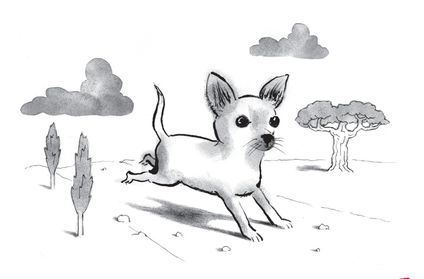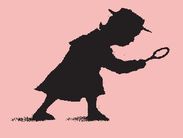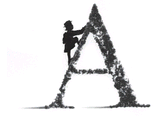The Word Snoop (11 page)
Authors: Ursula Dubosarsky

I
think this sentence is trying to tell me something—and not just about venomous earwigs. This is actually a mnemonic (pronounced
nem-on-ik
). A mnemonic is the word for tricks we can play with our minds to help us remember things. Like the order of the planets in the solar system . . .
think this sentence is trying to tell me something—and not just about venomous earwigs. This is actually a mnemonic (pronounced
nem-on-ik
). A mnemonic is the word for tricks we can play with our minds to help us remember things. Like the order of the planets in the solar system . . .
Mercury Venus Earth Mars Jupiter
Saturn Uranus Neptune
Saturn Uranus Neptune
Do you see? The beginning letters of each word in that first sentence stand for the beginning letters of the planets in the order they appear in the sky. For some reason, it’s easier to remember a silly sentence than the names of the planets themselves.
The word
mnemonic
comes from one of the Titans in ancient Greek mythology. Her name was Mnemosyne (
Nem-oss-in-ee
) and she represented memory. In the ancient world, memory was especially important when there weren’t many books and not many people learned to read. People used to memorize pages and pages of the books everyone wanted to hear, like
The Odyssey
or the Bible, and hundreds of types of mnemonics were developed to help them do this. Nowadays we would find it incredible that people could remember that much, but of course back then they didn’t have a choice. It wasn’t until the fifteenth century, after the printing press was invented, that the need for such amazing acts of memory fell away.
mnemonic
comes from one of the Titans in ancient Greek mythology. Her name was Mnemosyne (
Nem-oss-in-ee
) and she represented memory. In the ancient world, memory was especially important when there weren’t many books and not many people learned to read. People used to memorize pages and pages of the books everyone wanted to hear, like
The Odyssey
or the Bible, and hundreds of types of mnemonics were developed to help them do this. Nowadays we would find it incredible that people could remember that much, but of course back then they didn’t have a choice. It wasn’t until the fifteenth century, after the printing press was invented, that the need for such amazing acts of memory fell away.
But not totally! There are still things we need to remember. When the Word Snoop was at school, she learned the Great Lakes from west to east across Michigan with the sentence: Sam’s Horse Must Eat Oats—
Superior, Huron, Michigan, Erie, Ontario.
(You’d be surprised how often this information comes in handy . . . )
Superior, Huron, Michigan, Erie, Ontario.
(You’d be surprised how often this information comes in handy . . . )
There are many different types of mnemonics. For example, to remember the difference between spelling desert and dessert, you can say “the sweet one has two sugars.” (Two S’s, get it?) And what about the rhyme to remember the number of days in each month (“Thirty days has September . . .” and so on). That’s a mnemonic too. And have you seen the episode of
The Simpsons
when Bart and Lisa help Marge to study for a big exam by putting all the facts she needs to remember to the tune of a song? I bet your teacher or your parents might know some mnemonic tricks like this. (Go on, ask them.)
The Simpsons
when Bart and Lisa help Marge to study for a big exam by putting all the facts she needs to remember to the tune of a song? I bet your teacher or your parents might know some mnemonic tricks like this. (Go on, ask them.)
You can have lots of fun with mnemonics. In music, children often learn a mnemonic for the order the notes come on the staff:
Every Good Boy Deserves Fruit
(EGBDF). But look what other people have made up to remember the same thing:
Empty Garbage Before Dad Freaks; Elephants Go Bouncing Down Freeways; Evil Godzilla Buys Dog Food
.
Every Good Boy Deserves Fruit
(EGBDF). But look what other people have made up to remember the same thing:
Empty Garbage Before Dad Freaks; Elephants Go Bouncing Down Freeways; Evil Godzilla Buys Dog Food
.
Here’s one the Word Snoop just invented—can you guess what it stands for?
Remarkable Children Understand Challenging Books
(Hint: Think of the five largest countries.)
Why don’t you make up a mnemonic of your own? Come on, Word Snoops—have fun, and improve your memory at the same time!
OxymoronsOxymoron. (Don’t you mean foxymoron? No, I mean oxymoron!) It’s one of those words you don’t forget once you’ve heard it. But what on earth does it mean?
Like lots of unusual words in English, it comes from the language of the ancient Greeks—
oxys
, which means “sharp,” and
moros
, which means “silly” or “dull.” It’s used to describe expressions that contain two opposite ideas—in other words, something that is “sharply dull.”
oxys
, which means “sharp,” and
moros
, which means “silly” or “dull.” It’s used to describe expressions that contain two opposite ideas—in other words, something that is “sharply dull.”
Hmm, maybe some examples would help. Has anyone ever said to you, “that’s
old news”?
This is an oxymoron because it’s contradicting itself—news can’t be old, because it’s
new
. And then there’s that song by Simon and Garfunkel, “The
Sound
of
Silence.
” How can silence have sound? So that’s an oxymoron too. And so is the cartoon character Charlie Brown’s favorite line—“
Good grief!”
old news”?
This is an oxymoron because it’s contradicting itself—news can’t be old, because it’s
new
. And then there’s that song by Simon and Garfunkel, “The
Sound
of
Silence.
” How can silence have sound? So that’s an oxymoron too. And so is the cartoon character Charlie Brown’s favorite line—“
Good grief!”
Writers have been using oxymorons for thousands of years, all over the world, in many languages and cultures. The ancient Chinese philosopher Lao-Tzu said, “To
lead
the people, walk
behind
them,” and the English playwright William Shakespeare wrote, “I do
believe
her, though I know she
lies.
” The nineteenth-century French novelist Victor Hugo spoke of “the
pleasure
of being
sad ,
” and in the twentieth century, the American poet T. S. Eliot described the “
pleasant whining
of a mandolin.” Well, they all sound like very interesting gentlemen . . .
lead
the people, walk
behind
them,” and the English playwright William Shakespeare wrote, “I do
believe
her, though I know she
lies.
” The nineteenth-century French novelist Victor Hugo spoke of “the
pleasure
of being
sad ,
” and in the twentieth century, the American poet T. S. Eliot described the “
pleasant whining
of a mandolin.” Well, they all sound like very interesting gentlemen . . .
Because oxymorons have a way of grabbing your attention, you will often find them in advertising. You know, things like
genuine imitation
or
seriously funny
. Movie titles also use oxymorons to make you look twice
—
think of
Back to the Future, Eyes Wide Shut,
or
True Lies
.
genuine imitation
or
seriously funny
. Movie titles also use oxymorons to make you look twice
—
think of
Back to the Future, Eyes Wide Shut,
or
True Lies
.
And then there are those people who like to use oxymorons as a form of humor. Like your teacher might say, “I’ve got some
lovely home-work
for you today.” (Ha ha.) Or, “I want a
compulsory volunteer
to clean up the playground.” (Hilarious.) Well, you could always answer back, “Excuse me, you are
clearly confused
.”
lovely home-work
for you today.” (Ha ha.) Or, “I want a
compulsory volunteer
to clean up the playground.” (Hilarious.) Well, you could always answer back, “Excuse me, you are
clearly confused
.”
I wonder why oxymorons are so appealing? Perhaps it’s because an oxymoron is really a kind of paradox—something that appears to be true and false at the same time. The world can sometimes seem so large and strange, and many human experiences just don’t make sense. As the great poet Walt Whitman wrote, “Do I contradict myself? Very well, then, I contradict myself. (I am large—I contain multitudes.)” (Gosh!)
Maybe an oxymoron is a way for a writer to express those mixed-up feelings—and hopefully for a reader to try to understand them. So next time you’re writing a story or a poem or a report on something, why don’t you try putting in an oxymoron or two?
In the meantime, try spotting the oxymorons on the next page in the story that the Word Snoop made up about a little dog.
A tragicomedy of a lost dog
A gigantic Chihuahua was hurrying slowly
along the soft, stony road. He came to
a low tower of delicious rotten turnips.
Daintily he wolfed them down. But
then his tummy felt as light as a bag of
cement, so he decided to have a long nap.
Instantly his owner finally arrived.
along the soft, stony road. He came to
a low tower of delicious rotten turnips.
Daintily he wolfed them down. But
then his tummy felt as light as a bag of
cement, so he decided to have a long nap.
Instantly his owner finally arrived.
“Fluffy!” whispered his owner in a loud
voice, fondly pulling the dog’s hairless fur.
“You darling little monster. I think I might
have definitely missed you.”
voice, fondly pulling the dog’s hairless fur.
“You darling little monster. I think I might
have definitely missed you.”


Word Snoops, guess what time it is? That’s right
—
code time! I hope this one’s not too tricky for you. (Hint: Palindromes read forward and . . . ?)
—
code time! I hope this one’s not too tricky for you. (Hint: Palindromes read forward and . . . ?)
TAHT YAS OT YPPAH YREV M ’ I
Answers
PALINDROMES
1.
Dad
Dad
2.
Pop
Pop
3.
Redder
Redder
4.
Kayak
Kayak
5.
Deed
Deed
6.
Toot
Toot
7.
Peep
Peep

Dear Snoops,
It’s time for some FUN!
YAY!!!
Okay, calm down for a moment. We’re going to
play some games, but you’ll still need to have
your brains switched on.
play some games, but you’ll still need to have
your brains switched on.
You see, you can play games with bats and balls
and toys and a hundred other things, but you
can also have a great time playing with words.
You can play around with the sounds, or the
meanings, or both at once
—
and anything else
you can find.
and toys and a hundred other things, but you
can also have a great time playing with words.
You can play around with the sounds, or the
meanings, or both at once
—
and anything else
you can find.
Come on, let’s play!
Your ludic friend,
The Ord-way Noop-say
P.S. What do you think the Word Snoop’s
favorite game is? Yep, you guessed it
—
I Spy!
favorite game is? Yep, you guessed it
—
I Spy!

6.
Who likes playing games?
Pig LatinH
ave you ever wanted to speak a secret language? Here’s an easy one to learn. It’s called Pig Latin.
ave you ever wanted to speak a secret language? Here’s an easy one to learn. It’s called Pig Latin.
Now, Latin is the language that the ancient Romans used to speak, and you know what pigs are. (Hint: They go
oink, oink
!) Can pigs really speak Latin? Well, no, actually. Pig Latin has got nothing to do with Latin or pigs. It’s just a funny kind of language-game children and adults have been playing for years. Like rhyming slang, it may have started as a kind of thieves’ language, a way of disguising what you were saying to confuse anyone who might have been listening.
oink, oink
!) Can pigs really speak Latin? Well, no, actually. Pig Latin has got nothing to do with Latin or pigs. It’s just a funny kind of language-game children and adults have been playing for years. Like rhyming slang, it may have started as a kind of thieves’ language, a way of disguising what you were saying to confuse anyone who might have been listening.
Even though nobody really knows who started it, or why it’s called Pig Latin, we do know that it’s been around since at least the 1920s—in the playground, in movies, in songs and in stories. The famous old movie star Ginger Rogers sang a song in Pig Latin in the movie
Gold Diggers of 1933.
And if you ever get a chance, listen to the wonderful folk singer Lead Belly singing “The Pig Latin Song,” which he recorded way back in the 1940s. Do some snooping and see if you can still find a recording of it online.
Gold Diggers of 1933.
And if you ever get a chance, listen to the wonderful folk singer Lead Belly singing “The Pig Latin Song,” which he recorded way back in the 1940s. Do some snooping and see if you can still find a recording of it online.
When the Word Snoop was at school, all the children in the playground spoke Pig Latin. Maybe your teacher knows it, or your parents, or your grandparents. But it’s not just old folks. Even Krusty the Clown on
The Simpsons
has been known to speak a bit of Pig Latin!
The Simpsons
has been known to speak a bit of Pig Latin!
Here’s how it works. It’s pretty easy, once you get the hang of it. Take away the first letter of the word you want to say, and put it at the end of that word. So for the word DOG, for example, take away the D and put it at the end, so you’ve got OG-D. Then you follow it by the two letters AY. That’s it! So DOG in Pig Latin becomes OG-DAY. Can you work out what CAT would be? Think about it. That’s right—AT-CAY!
See! Easy-ay! Oh! That reminds me. There’s just one more rule. If a word begins with a vowel (a, e, i, o, u), then you just put AY on the end of the word, without taking the first letter away. So the word EASY, as you see, just becomes EASY-AY. And if a word begins with something like a CH or a TH or a SH, like SHAKE THAT CHOP, you take the whole sound, not just the first letter—AKE-SHAY AT-THAY OP-CHAY! (Not that hard!)
Other books
Royal Seduction by Donna Clayton
The Witch of Little Italy by Suzanne Palmieri
Girl of Rage by Charles Sheehan-Miles
Fragile by Veronica Short
H.J. Gaudreau - Betrayal in the Louvre by H.J. Gaudreau
The Apprentice's Masterpiece by Melanie Little
Ricochet by Krista Ritchie, Becca Ritchie
The Journal of Joyce Carol Oates by Joyce Carol Oates
The Brotherhood of the Screaming Abyss by Dennis McKenna
Talon's Heart by Jordan Silver
